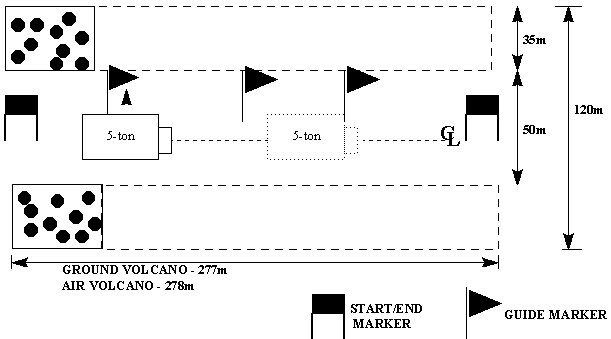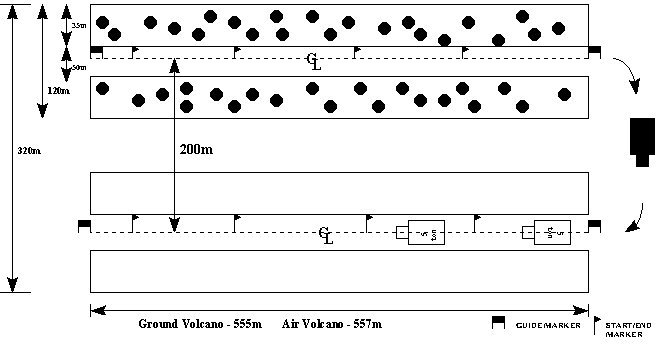 The Volcano Mine Dispenser provides soldiers with a scatterable mine capability delivered by
helicopter or ground vehicle. The Volcano dispenser contains 960
anti-tank/anti-personnel mines and is capable of rapidly laying a minefield 1100 meters
long by 120 meters wide. In addition, the mines have a timed self-destruct capability.
The Volcano Mine Dispenser provides soldiers with a scatterable mine capability delivered by
helicopter or ground vehicle. The Volcano dispenser contains 960
anti-tank/anti-personnel mines and is capable of rapidly laying a minefield 1100 meters
long by 120 meters wide. In addition, the mines have a timed self-destruct capability.
The VOLCANO system can be configured as both a heliborne and ground delivered mine system. The M139 mine dispenser, with various adapter kits, is capable of being mounted on UH-60 helicopters and a variety of ground vehicles. The dispenser racks accept and launch mines from the M87 mine canisters which contain five GATOR anti-tank (AT) and one anti- personnel (AP) mine each.
STATUS: The ground mounted VOLCANO systems are currently being fielded. The Air VOLCANO contract was recently awarded to Brunswick Corp. Air VOLCANO production started Jan 95 and completed Jul 95. First Unit Equipped (FUE) date was Aug 95.
EMPLOYMENT CONCEPT: VOLCANO will be employed offensively and defensively to delay enemy movement, isolate the battlefield and reinforce friendly fires. VOLCANO will become the standard helicopter mine dispensing system and will replace the M56 system. VOLCANO will be a principal scatterable mine delivery system for light forces, and will replace Ground Emplaced Mine Scattering System (GEMSS) in heavy forces.
The operator uses the dispenser control unit (DCU) to electrically control the dispensing operation from within the carrier vehicle. The DCU provides controls for the arming sequence and the delivery speed selection. It also sets mine self-destruct times. The DCU allows the operator to start and stop mine dispensing at any time. A counter on the DCU indicates the number of canisters remaining on each side of the carrier. An explosive propelling charge dispenses from their canisters. For ground vehicles, mines are dispensed 25 to 60 meters from the vehicle at ground speeds of 5 to 55 mphs. For aircraft, mines are dispensed 35 to 70 meters from the line of flight. The aircraft flies at a minimum altitude of 5 feet, at speeds of 20 to 120 knots. It can deliver up to 960 mines (160 canisters) per sortie. The Volcano uses the host vehicle as a power source. Attaching the system to the vehicle does not significantly degrade its mobility. Except for the mounting hardware, there is total system commonality between air and ground Volcano systems.
The ground Volcano allows for placement of large minefields in depth. Combat engineer units normally employ the ground Volcano. The primary use of mounted dispensers is to emplace tactical minefields oriented on enemy forces in support of maneuver operations and friendly AT fires. The system is vulnerable to direct and indirect fires, so units must protect it when close to the FLOT. It is an ideal obstacle reserve, employed when the enemy reaches a decision point that indicates future movement. With this asset, units can place obstacles on avenues the enemy is using, leaving other avenues open for friendly movement.
Air VOLCANO dispenses its full payload in 17 seconds at 120 knots.
BASIS OF ISSUE: The VOLCANO mine dispenser will be issued to selected Assault Helicopter Companies at three per company (only one company per Division/Corps/Armored Cavalry Regiment). VOLCANO will be issued at two per Combat Engineer Company in ERI, Airborne and Light.
TRAINING/PERSONNEL: The M88 Practice Mine Canister (which expels six inert mines) and the M89 inert training canister are the VOLCANO training devices. VOLCANO operation requires no special skills; and a designated rather than dedicated operator will be used. Resident training will be for familiarization only. Semi-annual operator refreshers are expected to be sufficient to maintain proficiency.
GENERAL
Ground and Air Delivery Systems (5-ton, M548 Cargo, UH-60)
Each Mine Canister has 5 AT and 1 AP mines
Three Field Selectable SD Times (4 hrs/ 48 hrs/15 days)
UH -60A can deliver 960 mines(160 canisters) per sortie
5 - ton and M548 can hold 160 canisters ( four racks each holding 40 canisters)
Uses Host Vehicle as a power source
Same system is used on both ground and air except for mounting
Each Light Engineer Battalion is authorized three
Each Aviation Brigade is authorized three
EMPLOYMENT
Provide capability to rapidly emplace large minefields under varying conditions
Quickly attached to aerial and ground vehicles Missions included:
Tactical Minefields, Reinforce existing obstacles, Close lanes gap and defile, Protect flank, Deny enemy ADA site
Excellent Reserve Obstacle
EMPLACEMENT
Average AT and AP linear density of 0.72 and 0.14 mines/meter
Site layout extremely important:
*Mine field limits are premarked fencing emplaced 80 meters from centerline, 40 meters from start/stop points
*Fence is emplaced prior to dispensing if situation permits
*Must be marked before turning over to adjacent unit or maneuver unit
Special considerations for air delivery:
*More rapid delivery = less accuracy
*Use positive control techniques: visual ID, time lapse, # of canisters fired, Doplar guidance and permission coordination
*End points must be visually marked for pilot
*Emplaced in friendly area must be marked by fence 100m from centerline, 100m from start/stop points
Safety zone is 640 meters from boundary of minefield
VOLCANO
| DEPTH | FRONT
GROUND |
FRONT
AIR |
# OF MINES
(AT/AP) |
# MINEFIELD
PER 5 TON |
|
| DISRUPT | 120 | 277 | 278 | 200/40 | 4 |
| FIX | 120 | 277 | 278 | 200/40 | 4 |
| TURN | 320 | 555 | 557 | 800/160 | 1 |
| BLOCK | 320 | 555 | 557 | 800/160 | 1 |
Ground/Air Volcano
Disrupt and Fix Minefields

Ground/Air Volcano
Turn and Block Minefields



